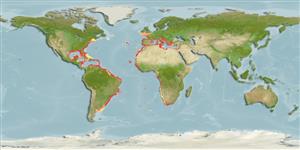Teleostei (teleosts) >
Eupercaria/misc (Various families in series Eupercaria) >
Sparidae (Porgies)
Etymology: Pagrus: Greek, pagros = a fish, Dentex, sp. (Ref. 45335).
More on author: Linnaeus.
Environment: milieu / climate zone / depth range / distribution range
Ecology
Marine; benthopelagic; oceanodromous (Ref. 51243); depth range 0 - 250 m (Ref. 3688), usually 10 - 80 m (Ref. 9626). Subtropical; 51°N - 43°S, 98°W - 36°E
Eastern Atlantic: Strait of Gibraltar to 15°N (rare southward 20°N), including Madeira and the Canary Islands; Mediterranean and northward to the British Isles. Western Atlantic: New York, USA and northern Gulf of Mexico to Argentina (Ref. 7251), including the continental coast of the Caribbean Sea (Ref. 9626).
Length at first maturity / Size / Weight / Age
Maturity: Lm 26.6, range 19 - ? cm
Max length : 91.0 cm TL male/unsexed; (Ref. 9710); common length : 35.0 cm SL male/unsexed; (Ref. 4781); max. published weight: 7.7 kg (Ref. 40637); max. reported age: 26 years (Ref. 123644)
This species is distinguished by the following characters: body oval, moderately deep. Head profile convex, slightly steeper in front of eye; 6 or 7 rows of scales on cheeks; preopercle scaleless; both jaws anteriorly with large canine-like teeth, 4 in upper and 6 in lower jaw, followed by smaller and blunter canine-like teeth that become progressively molar-like toward the posterior third of jaws; the 2 outer rows of strong teeth are flanked in the region anterior to the molars by several rows of very small teeth; gill rakers short, lower limb of first arch with 8 to 10, 6 to 8 on upper limb. Dorsal fin with 12 spines and 9 to 12 soft rays; anal fin with 3 spines and 8 or 9 soft rays. Scales along lateral line 52 to 60. Colour: pink with silvery reflections, lighter on belly; head dark from nape to angle of mouth; sometimes, fine blue dots present on upper sides, particularly conspicuous in young individuals; often a somewhat darker area at pectoral fin axils; caudal fin dark pink, with both tips white; other fins pinkish (Ref. 109259).
Found over rock, rubble, or sand bottoms (young frequently found on seagrass beds and the continental shelf (Ref. 47377)) down to about 250 m depth, often above 150 m. In southwest Brazil found in 160 m depth (Ref. 47377). Feeds on crustaceans, fishes, and mollusks (Ref. 3688). Its toxic nature is uncertain (Ref. 4690). Marketed fresh and frozen (Ref. 9987). Reported weights of caught individuals were between 9 to 17 kgs (9-10 off the west coast of Greece) (Hans Bollnert, hassebollnert@yahoo.gr, pers.comm. 12/09). It is parasitised by the monogeneans Anoplodiscus longivaginatus and Anoplodiscus richiardii (species inquirenda) on the fins and body surface (Ref. 124057).
Protogynous hermaphrodite species. First sexual maturity occurs at 3 years of age (about 24 cm), first behaving as females and then as males. Spawning happens at 1 5-19° and it tends to be in spring,
depending on the habitat (in the Canary Islands it can start in January). Also Ref. 28504, 41163.
Bauchot, M.-L. and J.-C. Hureau, 1990. Sparidae. p. 790-812. In J.C. Quero, J.C. Hureau, C. Karrer, A. Post and L. Saldanha (eds.) Check-list of the fishes of the eastern tropical Atlantic (CLOFETA). JNICT, Lisbon; SEI, Paris; and UNESCO, Paris. Vol. 2. (Ref. 3688)
IUCN Red List Status (Ref. 130435)
Threat to humans
Reports of ciguatera poisoning (Ref. 4690)
Human uses
Fisheries: commercial; aquaculture: commercial; gamefish: yes; aquarium: public aquariums
Tools
Special reports
Download XML
Internet sources
Estimates based on models
Preferred temperature (Ref.
123201): 15.8 - 27.8, mean 24.1 °C (based on 1356 cells).
Phylogenetic diversity index (Ref.
82804): PD
50 = 0.5156 [Uniqueness, from 0.5 = low to 2.0 = high].
Bayesian length-weight: a=0.01318 (0.01197 - 0.01451), b=3.03 (3.00 - 3.06), in cm total length, based on LWR estimates for this species (Ref.
93245).
Trophic level (Ref.
69278): 3.9 ±0.2 se; based on diet studies.
Generation time: 6.6 (5.1 - 10.0) years. Estimated as median ln(3)/K based on 14
growth studies.
Resilience (Ref.
120179): Medium, minimum population doubling time 1.4 - 4.4 years (K=0.13-0.27; tmax=11; tm=0.9-3.0).
Prior r = 0.52, 95% CL = 0.34 - 0.78, Based on 7 stock assessments.
Fishing Vulnerability (Ref.
59153): Moderate to high vulnerability (48 of 100).
Climate Vulnerability (Ref.
125649): Moderate to high vulnerability (51 of 100).
Nutrients (Ref.
124155): Calcium = 33.4 [18.0, 61.6] mg/100g; Iron = 1 [0, 2] mg/100g; Protein = 19.8 [18.2, 21.3] %; Omega3 = 0.3 [0.2, 0.5] g/100g; Selenium = 39.3 [18.2, 75.9] μg/100g; VitaminA = 14.7 [4.2, 49.5] μg/100g; Zinc = 0.618 [0.326, 1.227] mg/100g (wet weight); based on
nutrient studies.
